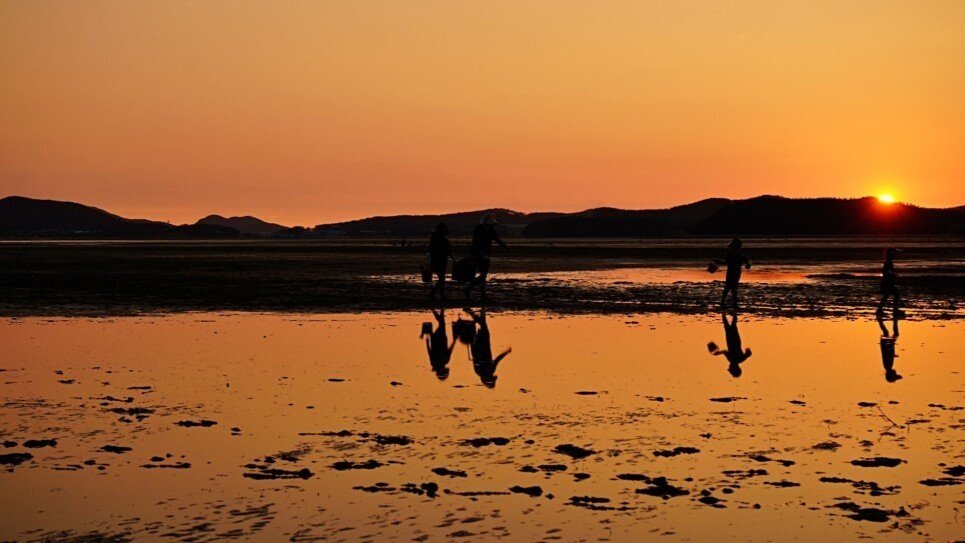CENTRAL
Central x Atomix
Welcome to the Central x Atomix collaboration.
Connecting territories and ecosystems turns out to be the cornerstone of our work.
What better scenario than this one to celebrate the human capacity to innovate and be creative while maintaining cultural roots.
Bienvenidos a esta experiencia.
Chef Virgilio Martínez
-
LIMA l CENTRAL
— Sea lettuce - Razor clams - EspirulinaThe Pacific accompanies Lima from north to south. Clear in summer months like these, devoid of the thick fog that characterizes it, it reveals the very dark blue-green tone, which envelops hundreds of species in an extremely rich habitat.
-
TIDELAND l ATOMIX
— Pen shell clam - Makgeolli - Hamcho
— Korean Flounder - Calabash - Squid inkTaean is located in the western part of Korea. The region is famous for its coastline, considered one of Korea’s most beautiful, as well as its fruitful tidelands. The tidal flats are historied to be a significant grounds for sea life, including Korean venus clams, littleneck clams, as well as sea vegetables.
In December of 2007, a major collision of a crane barge and crude carrier resulted in an oil spill, the most devastating pollution incident of Korean history. While the incident’s environmental impact is heavily recorded, it became a catalyst to a collective activism and reform to restore, and reverse human pollution and damage. Today, Taean is once again a habitat sanctuary to countless organisms.
This dish is inspired by these memories.
Taean tidelands
-
Altiplano l CENTRAL
— Black Mashua - Maca Root - Cow’s heart
A plateau of extreme altitude, home to native potato varieties, and tubers that are left exposed to the sun on colorful cloaks to become sweeter as the days go by.
-
Volcano Island l ATOMIX
— Hallabong - Golden eye snapper - Gamtae
Jeju is an island in the southwest of South Korea, a volcanic island formed from historic volcanic activity. It is the largest by physical size, as well as the population, of Korea’s islands. Jeju Island is registered as a UNESCO World Natural Heritage Site under the title ‘Jeju Volcanic Island and Lava Tubes’, the only recognized World Natural Heritage Site in Korea.
Another beloved Korean name for Jeju Island is ‘citrus county’ due to its abundance of heritage citrus. Through the combination of citrus and fish - Jeju is also famous for its wealth of seafood - I wanted to express Jeju and its natural beauty which represents Korea to the world.
-
Amazonia l CENTRAL
— Cassava - Yuca - Jamaica scoby
This southeastern rainforest is unique because of its resource density, variable climate, intense rainfall, and immense and ancestral guardian trees. Yucca is linked to native cooking customs, direct fire cooking and comforting and familiar preparations.
-
Winter Hill l ATOMIX
— Dallae (wild onion) - Shrimp - Yuza
Seosan, Chungcheongnam-do, located in the central western part of the Korean Peninsula, is known for its hilly terrains of gentle slopes with an average elevation of 100m. Seosan is close to the West Sea, and thus famous for its aquatic products such as octopus and shrimp, The most famous specialties though are its garlic, ginger, and dallae - Korean wild onion - grown in its gentle lands.
Dallae is a spring vegetable which represents Korea. The sprouting of dallae always marks the start of the sweet spring, after enduring Korea’s long, cold winter. Dallae was always considered a valuable crop that generated an appetite that had been forgotten during the winter.
While we’re still in the middle of a long winter, we hope you have anticipation for a new spring through the sweet scent of dallae.
Maras salt mines
-
MIL Moray Lab l CENTRAL
— Diversity of Corn - Elderberry - Kiwicha
In MIL we connect. With people, with landscapes, and with scenes of daily life that are much more than surprising. The salt mines of Maras, the farms of thousands of Andean products, water sources such as high altitude oxbow lakes and mighty rivers that flow through a very fertile valley. In harvest months, the colorful corn rests fresh, looking like colorful mountains.
-
Sea Breeze l ATOMIX
— Gwamegi - Miyeok - Buchu
Pohang is the largest city in Gyeongsangbuk-do, located in the southeast of South Korea. The city has a historic fishing industry, with much of the city’s economy rooted in it. Even now, the region has the highest fishery production in Gyeongsangbuk-do, serving as the center of the fishery industry.
Of its famed products, gwamegi is a local specialty. Gwamegi is herring or saury, made by being slow-dried over three to ten days, hung with hand-threaded straw strings, in the cold sea breeze of the winter. This produces a unique chewy texture unlike any other dried fish. Though a port city, known for seafood, it is also famous for its native chives.
Please enjoy the unique taste of gwamegi, a traditional delicacy of Korean winters.
-
Dry Valley l CENTRAL
— Loche squash - River shrimp - Limo Aji
The desert, monochromatic, looks devoid of things, it seems that nothing exists, and there is silence, and time seems to flow slowly. But when it crosses the river, full of species, it allows the border to offer land for native pumpkins, and the silence is broken by its flow and all the green that grows.
-
Boundary l ATOMIX
— Gosari - Bamboo - Dubu / Cheongguk jang - Red adirondack potato
Jirisan is the second highest mountain in Korea after Hallasan, and the highest on the mainland. Jirisan is also a mountain range that spans Gyeongsangnam-do, Jeollabuk-do, and Jeollanam-do, literally shaping the history and culture of Korea.
Its role is many, each important. It acted as a trade route which facilitated the exchange of each region’s goods, and cultures. Its religious and spiritual role is still significant to this day, as a land with deep religious and magical energy. Even now, it is a site of pilgrimage and rituals, where many go to pray, meditate, or study, in clear, good chi during important moments.
As a fertile mountain range, it is home to a rich variety of vegetation and wildlife. Throughout history, it naturally became an important place where Korea’s unique foraging, hunting and gathering culture grew and developed. I hope you will feel the simple yet profound taste of the Korean mountain vegetables and Jang culture.
-
Marcona l CENTRAL
— Scallops - Sargassum - Yuyo
A fraction of very blue sea, very dense, very rough waves, surrounded by huge blackish rocks, the ground is gray sand, and remains of shells of different shades, the sun burns intense.
-
The Clear South Sea l ATOMIX
— Wild Turbot - Chrysanthemum - Moo
Hallyeosudo Tongyeong is located at the southern tip of Gyeongsangnam-do. It is famous for its wealth of delicious food, as the region combines the advantages of a coastal city surrounded by sea on three sides with the active exchange with the capital.
Coveted ingredients are available throughout the season in abundance, from both the seas and the land. There is a Korean saying to gain strength in accordance with the energy of nature, one should eat sea urchin and flounder and mugwort soup in the spring and eel soup in summer. When the cold winds begin to blow, the grandeur of the sea’s feast unfolds splendidly.
This dish was made with the seafood coming from the deep, clear sea of Tongyeong, and the fragrant mugwort of its fertile soil in mind.
-
Northern Cordillera l CENTRAL
— Pork belly - Ollucos - Porcon Mushrooms
To the north we approach the tropics, but the Andes mark a different microclimate at this convergence. Introduced pine forests left varieties of mushrooms with special aromas, warm tones and creamy textures. The heights are always tuber soil.
-
Gangwon-do l ATOMIX
— Hanwoo - Deodeok - Chunri jang
Gangwon-do is located in the center of the Korean Peninsula, and Hoengseong a famously clean region where clear waters run, surrounded by lush, green mountains. The natural harmony of its ecosystem creates the optimal environment for the unique taste of Korean beef thrives. The taste of the meat is known to be superior to that of other regions.
We combined Hanwoo, Korean beef, with another precious ingredient of Hoengseong. Deodeok is a precious Korean root vegetable, revered for its unique taste and texture as well as nutrient density. It is considered even more valuable than Korean beef when harvested wild in the mountains.
The dish was made by combining these two important ingredients in Hoengseong.
Andean landscape
-
Andean Forest l CENTRAL
— Cactus - Cabuya - Chirimoya
The Andes occasionally meet the Amazon and a conversation takes place at high altitudes, between thick greenery and wetlands, resilient plants such as cacti, and fruits of mountain trees.
-
Naju Plains l ATOMIX
— Korean pear - Omija tea - Sikhae
Naju is an archetypical rural, agricultural city in Jeolla-do. The most famous product from Naju is its pear; the history of the Naju pear goes as far back as recorded history of pear in Korea. There is a saying that the Korean pear originated from Naju.
Naju pears are excellent, its supreme sweetness and taste originating from the high quality soil in the Yeongsan River basin, the optimum climatic conditions, as well as long-term agricultural wisdom. They were so prized that they were presented to the King in ancient times. Compared to other pears, they boast a larger size, a unique fragrance, thinner skin, with its soft flesh bursting with juice and sweetness.
-
High Jungle l CENTRAL
— Cacao Chuncho
From MIL, the route to the high jungle leads us through winding roads and cloud forests, crossing green mountains, there are ups and downs that present us with changing and wonderful scenery. Arriving at a cacao plantation is to land and connect with an ecosystem to remember. One of fruitful trees, of fantastic fruity and floral scents.
-
Taebaek Mountain Range l ATOMIX
— Angelica - Jujube - Potato
Pyeongchang, located in Gangwon-do on the Korean Peninsula, is the coldest region in Korea all year round. Of the region, the Taebaek Mountains is especially of great significance, as it is the lengthiest mountain range in Korea, extending in the north-south direction across the eastern, central and southern parts of the Korean Peninsula. The mountain range’s divide results in two regions, Yeongseo and Yeongdong regions, which have many differences in its cuisine and culture.
The high-altitude Taebaek Mountains has the optimal conditions for producing pollution-free agricultural and livestock products due to its vast grasslands and clean natural environment. It is famous for the supreme ingredients it produces, including potatoes, apples, and buckwheat.
Central, and the culture that Chef Virgilio has established has always inspired me to look connect and learn to understand where tradition comes from. Oftentimes, progress comes from a rediscovery of the past. In cuisine and culture, it’s key to understand where our food comes from and how it can be sustainable in the long term.
I once said that I think the future is for chefs to be inspired by their own roots, yet to change how it is represented.
I hope that our journey together tonight have moved you to recognize your own rich histories, and to go forward with newfound inspiration.
Thank you for joining us tonight.
Chef Junghyun ‘JP’ Park








